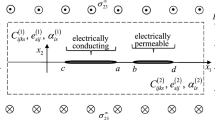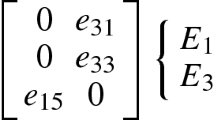Abstract
In this paper, the behavior of two collinear anti-plane shear cracks in a piezoelectric layer bonded to two half spaces is investigated by a new method for the impermeable crack face conditions. The cracks are parallel to the interfaces in the mid-plane of the piezoelectric layer. By using the Fourier transform, the problem can be solved with two pairs of triple integral equations. These equations are solved using the Schmidt method. This process is quite different from that adopted previously. Numerical examples are provided to show the effect of the geometry of the interacting cracks and the piezoelectric constants of the material upon the stress intensity factor of the cracks.
Similar content being viewed by others
References
Deeg, W.E.F., The Analysis of Dislocation, Crack and Inclusion Problems in Piezoelectric Solids, Ph.D. thesis, Stanford University, 1980.
Pak, Y.E., ‘Crack extension force in a piezoelectric materials’, ASME J. Appl. Mech. 57 (1990) 647–653.
Pak, Y.E., ‘Linear electro-elastic fracture mechanics of piezoelectric materials’, Int. J. Fract. 54 (1992) 79–100.
Sosa, H.A. and Pak, Y.E., ‘Three-dimensional eigenfunction analysis of a crack in a piezoelectric ceramics’, Int. J. Solids Struct. 26 (1990) 1–15.
Sosa, H., ‘Plane problems in piezoelectric media with defects’, Int. J. Solids Struct. 28 (1991) 491–505.
Sosa, H., ‘On the fracture mechanics of piezoelectric solids’, Int. J. Solids Struct. 29 (1992) 2613–2622.
Suo, Z., Kuo, C.-M., Barnett, D.M. and Willis, J.R., ‘Fracturemechanics for piezoelectric ceramics’, J. Mech. Phys. Solids 40 (1992) 739–765.
Gao, H., Zhang, T.Y. and Tong, P., ‘Local and global energy rates for an elastically yielded crack in piezoelectric ceramics’, J. Mech. Phys. Solids 45 (1997) 491–510.
Li, X.F., Fan, T.Y. and Wu, X.F., ‘A Moving mode-III crack at the interface between two dissimilar piezoelectric materials’, Int. J. Engng. Sci. 38 (2000) 1219–1234.
Chen, Z.T., Karihaloo, B.L. and Yu, S.W., ‘A Griffith crack moving along the interface of dissimilar piezoelectric materials’, Int. J. Fracture 91 (1998) 197–203.
Chen, Z.T. and Karihaloo, B.L., ‘Dynamic response of a cracked piezoelectric ceramic under arbitrary electro-mechanical impact’, Int. J. Solids Struct. 36 (1999) 5125–5133.
Yu, S.W. and Chen, Z.T., ‘Transient response of a cracked infinite piezoelectric strip under anti-plane impact’, Fatigue Engng. Mater. Struct. 21 (1998) 1381–1388.
Sosa, H. and Khutoryansky, N., ‘Transient dynamic response of piezoelectric bodies subjected to internal electric impulses’, Int. J. Solids Struct. 36 (1999) 5467–5484.
Zhang, T.Y. and Hack, J.E., ‘Mode-III cracks in piezoelectric materials’, J. Appl. Phys. 71 (1992) 5865–5870.
McMeeking, R.M., ‘On mechanical stress at cracks in dielectrics with application to dielectric breakdown’, J. Appl. Phys. 62 (1989) 3316–3122.
Suo, Z., ‘Models for break-down resistant dielectric and ferroelectric ceramics’, J. Mech. Phys. Solids 41 (1993) 1158–1176.
Dunn, M.L., ‘The effects of crack face boundary conditions on the fracture mechanics of piezoelectric solids’, Engng Fract. Mech. 48 (1994) 38–94.
Zhang, T.Y. and Tong, P., ‘Fracture mechanics for a mode III crack in a piezoelectric material’, Int. J. Solids Struct. 33 (1996) 343–359.
Sosa, H. and Khutoryansky, N., ‘New developments concerning piezoelectric materials with defects’, Int. J. Solids Struct. 33(23), (1996) 3399–3414.
Tauchert, T.R., ‘Cylindrical bending of hybrid laminates under thermo-electro-mechanical loading’, J. Thermal Stresses 19 (1996) 287–298.
Lee, J.S. and Jiang, L.Z., ‘Exact electro-elastic analysis of piezoelectric laminate via state space approach’, Int. J. Solids Struct. 33 (1996) 977–989.
Batra, R.C. and Liang, X.Q., ‘The vibration of a rectangular laminated elastic plate with embedded piezoelectric sensors and actuators’, Comput. Struct. 63 (1997) 203–215.
Heyliger, P., ‘Exact solutions for simply supported laminated piezoelectric plates’, ASME J. Appl. Mech. 64 (1997) 299–311.
Shindo, Y., Domon, W. and Narita, F., ‘Dynamic bending of a symmetric piezoelectric laminated plate with a through crack’, Theor. Appl. Fract. Mech. 28 (1998) 175–186.
Narita, K., Shindo, Y. and Watanabe, K., ‘Anti-plane shear crack in a piezoelectric layered to dissimilar half spaces’, JSME Int. J., Series A 42 (1999) 66–72.
Morse, P.M. and Feshbach, H., Methods of Theoretical Physics, Vol. 1, McGraw-Hill, New York, 1958, pp. 925–937.
Wang, B., ‘Three dimensional analysis of a flat elliptical crack in a piezoelectric materials’, Int. J. Engng. Sci. 30(6) (1992) 781–791.
ark, S.B. and Sun, C.T., ‘Effect of electric field on fracture of piezoelectric ceramics’, Int. J. Fract. 70 (1995) 203–216.
Han, Xue-Li and Wang, Tzuchiang, ‘Interacting multiple cracks in piezoelectric materials’, Int. J. Solids Struct. 36 (1999) 4183–4202.
Narita, K. and Shindo, Y., ‘Anti-plane shear crack growth rate of piezoelectric ceramic body with finite width’, Theor. Appl. Fract. Mech. 30 (1998) 127–132.
Gradshteyn, I.S. and Ryzhik, I.M., Table of Integral, Series and Products, Academic Press, New York, 1980, pp. 1025–1031.
Erdelyi, A. (ed), Tables of Integral Transforms, McGraw-Hill, New York, 1954, Vol. 1, pp. 101–128.
Amemiya, A. and Taguchi, T., Numerical Analysis and Fortran, Maruzen, Tokyo, 1969, pp. 346–372.
Itou, S., ‘Three dimensional waves propagation in a cracked elastic solid’, ASME J. Appl. Mech. 45 (1978) 807–811.
Zhou, Z.G., Bai, Y.Y. and Zhang, X.W., ‘Two collinear Griffith cracks subjected to uniform tension in infinitely long strip’, Int. J. Solids Struct. 36 (1999a) 5597–5609.
Zhou, Z.G., Han, J.C. and Du, S.Y., ‘Investigation of a Griffith crack subject to anti-plane shear by using the non-local theory’, Int. J. Solids Struct. 36 (1999b) 3891–3901.
Author information
Authors and Affiliations
Rights and permissions
About this article
Cite this article
Zhou, ZG., Chen, JY. & Wang, B. Analysis of Two Collinear Cracks in a Piezoelectric Layer Bonded to Two Half Spaces Subjected to Anti-plane Shear. Meccanica 35, 443–456 (2000). https://doi.org/10.1023/A:1010351615603
Issue Date:
DOI: https://doi.org/10.1023/A:1010351615603




